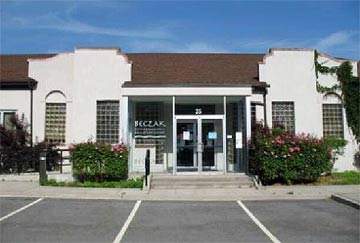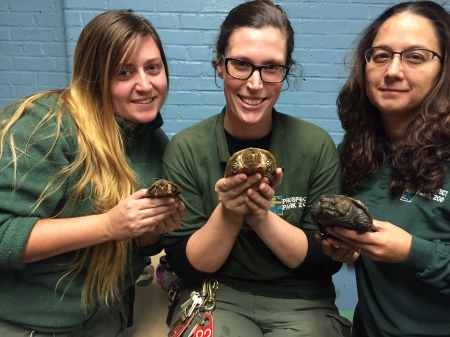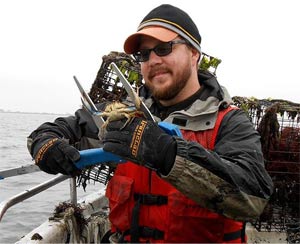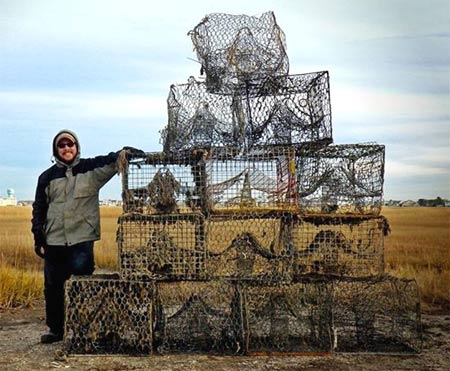 

The New York Turtle and Tortoise Society presents

Seminar 2015

Saturday, October 24, 2015
Check-in 9:30 a.m.; Sessions 10:00 a.m.–5:00 p.m.

Sarah Lawrence College Center for the Urban River at Beczak
35 Alexander Street, Yonkers, New York 10701

 |

Sarah Lawrence College Center for the Urban River
at Beczak in Yonkers, New York
|
We are pleased to announce that Seminar 2015, the 30th NYTTS Annual Seminar, will held at the Sarah Lawrence College Center for the Urban River at Beczak in Yonkers, New York. It is is an easy drive up from the city or down from points in Westchester County. Ample parking is available. It also just two blocks north of the Yonkers Metro North (Hudson River Line) station (see map and train schedules (PDF)).
This full-day event will feature three in-depth presentations by prominent herpetologists. The fee for the day, including morning coffee and lunch, is $45 per person ($20 for students with ID). Seating is limited: pre-register today!
There are two ways to register:
- Register by mail with check. Download and complete the Seminar 2015 Registration Form (PDF) and send in no later than Monday, October 19. (Online registration will be available until Thursday, October 22.)
-
  Register online by credit card through PayPal (you do not need a PayPal account). Registration deadline is Thursday, October 22. To help prevent automated spam, the registration form is password protected. Go to the Registration Form and enter the User Name and Password (shown on the right) when requested. Be sure to enter lowercase letters.
Register online by credit card through PayPal (you do not need a PayPal account). Registration deadline is Thursday, October 22. To help prevent automated spam, the registration form is password protected. Go to the Registration Form and enter the User Name and Password (shown on the right) when requested. Be sure to enter lowercase letters.
See Driving Directions to Beczak, PDF
|

 Scheduled Program
Scheduled Program

Nichole Shelmidine,1 Brittany Murphy,2 and Danielle Taylor-Lang3
 1
1Animal Supervisor, WCS/Prospect Park Zoo
2Senior Wild Animal Keeper, WCS/Prospect Park Zoo
3Wild Animal Keeper, WCS/Prospect Park Zoo
 “Husbandry and Propagation of the Chinese Big-Headed Turtle
“Husbandry and Propagation of the Chinese Big-Headed Turtle
(Platysternon megacephalum) at the Wildlife Conservation Society’s Prospect Park Zoo”


Danielle Taylor-Lang, Brittany Murphy and Nichole Shelmidine |
 The Chinese big-headed turtle (Platysternon megacephalum) is currently listed on IUCN’s red list as Endangered and on Cites appendix II. In 2008, as part of the Wildlife Conservation Society’s initiative on turtle and tortoise conservation, this species became a focus for propagation at Prospect Park Zoo. To simulate seasonal changes, water and ambient temperatures along with photoperiod were appropriately fluctuated. With our single breeding pair, we have obtained eggs for four consecutive years (2012–2015) and have had successful hatchings in 2013 and 2014. This year’s clutch is currently incubating and will hatch sometime in November. This presentation will share the team’s experiences working with this species as well as review previous publications and successes. Our hope is that our continued efforts to increase the knowledgebase and the sharing of information will result in a viable, sustainable captive population for this species.
The Chinese big-headed turtle (Platysternon megacephalum) is currently listed on IUCN’s red list as Endangered and on Cites appendix II. In 2008, as part of the Wildlife Conservation Society’s initiative on turtle and tortoise conservation, this species became a focus for propagation at Prospect Park Zoo. To simulate seasonal changes, water and ambient temperatures along with photoperiod were appropriately fluctuated. With our single breeding pair, we have obtained eggs for four consecutive years (2012–2015) and have had successful hatchings in 2013 and 2014. This year’s clutch is currently incubating and will hatch sometime in November. This presentation will share the team’s experiences working with this species as well as review previous publications and successes. Our hope is that our continued efforts to increase the knowledgebase and the sharing of information will result in a viable, sustainable captive population for this species.

Nichole Shelmidine is currently the Supervisor of Animals at the Prospect Park Zoo. She has a B.S. in Zoology and a Master's in Anthropology. She began her career in 1997 in the Bronx Zoo's mammal department working with primates and small mammals. In 2007, she transferred to the Prospect Park Zoo and became the Assistant Supervisor there, eventually becoming the Supervisor of Animals. During her tenure at Prospect Park Zoo, she became interested in fresh water turtles, particularly the Chinese big-headed turtle. In 2008, she began an initiative to advance the husbandry and propagation techniques for this species which in 2013 finally culminated into the first successful hatching within an AZA zoological institution. Nichole plans to continue to work with this species in the hopes of eventually helping to create a stable captive North American population.

Brittany Murphy graduated from Loyola University in Maryland with a B.S. in Biology. She has a background in aquatics but cultivated her interest for reptiles and amphibians while working at Animal Embassy, an exotic animal rescue with an emphasis on outreach education in Connecticut, where she learned to and succeeded in breeding and rearing snakes and tortoises. In 2012, Brittany was hired at the Prospect Park Zoo as a Wild Animal Keeper and joined the turtle team, helping to obtain PPZ's first clutch of Chinese big-headed turtle eggs. Brittany is now a Senior Wild Animal Keeper and the co-project coordinator for this endeavor, helping to oversee the husbandry and propagation of the adult big-headed turtles.

Danielle Taylor-Lang graduated from Nova Southeastern University, Florida in 2010 with a B.S in Marine Biology. In 2012, she began her career working at Busch Wildlife Sanctuary where she rehabbed and released a variety of species indigenous to Florida including the Florida box turtles and Gopher tortoises. Danielle worked at Turtle Back Zoo, N.J as an Animal Keeper before joining the WCS team in 2014. Currently she is a valued member of the Chinese big-headed turtle propagation program where her main focus is incubation and hatchling care.


Dr. Dora Pinou will discuss her sea turtle research program in Costa Rica, Mexico, and Florida, and introduce some of the biogeographical and taxonomic contributions she has made through this work. In addtion, she will explain how this new information is shaping sea turtle biology, conservation, and research on marine ecosystem health.

Theodora Pinou was born and raised in Washington Heights, New York City. She was fortunate to be accepted into The Bronx High School of Science and then entered New York University where she completed her bachelors, masters and doctoral degrees. She completed her Ph.D. in 1993 at New York University with Herndon G. Dowling, and went on to a post doc at Yale University in the Department of Ecology and Evolutionary Biology. She is a Curatorial Affiliate in Vertebrate Zoology at the Yale Peabody Museum of Natural History. She is interested in the biology and conservation of reptiles, and in developing methods of teaching science that increase motivation to learn by diverse learners. She continues to inspire young minds to consider the conservation and management of biological resources through Project Migration and Finding Our Way, two funded programs that bring together community stakeholders to find ways to respect the environment.


Ghost trap recovery fieldwork: abandoned crab traps (called “ghost traps”) continue to catch aquatic wildlife indefinitely. Here Ben Atkinson rescues a cold (but lucky) blue crab from a ghost trap; it was measured and released. |
|
 |
Ben Atkinson
Visiting Assistant Professor, Department of Natural Sciences
Flagler College, St. Augustine, Florida
 “Muddy Boats and Dusty Bones: Piecing Together the
“Muddy Boats and Dusty Bones: Piecing Together the
Story of Ghost Traps and Diamond-backed Terrapins”

Ghost traps are lost or abandoned fishing gear that continue to capture aquatic wildlife, causing cryptic mortality. An estimated 25–30 percent of all fished blue crab traps become ghost traps. Self-baiting, these may persist for years, “ghost fishing” until they disintegrate or are recovered. Ben employed side-scan sonar at high tides and high-powered optics during spring low tides to help locate and retrieve ghost traps on New Jersey’s Cape May Peninsula. Diamond-backed terrapins drown in both actively fished and derelict crab traps. Terrapins are especially vulnerable as long-lived vertebrates whose life history traits make them susceptible to population declines.

Ben investigated the demographic impacts of ghost traps on diamond-backed terrapins by estimating minimum mortality levels from salvaged skeletal remains. He also employed allometry techniques to extrapolate the body sizes of the original live terrapins. This allowed him to determine which terrapins would have been excluded from traps if they had been fitted with bycatch reduction devices (BRDs).
 |
 |

Ben with 13 ghost traps recovered at the end of the 2013 season
|
To describe these bone-based investigations, he coined the term “conservation osteology.” Ultimately, he is seeking to reduce terrapin mortality through increased awareness—and widespread use of bycatch reduction technology. He will present background information, field and lab techniques, results and their conservation implications, and discuss directions for future research and management.

Ben Atkinson received his Ph.D. in Wildlife Ecology and Conservation from the University of Florida (UF). Previously, he earned a B.S.Ed. in Environmental Education at Slippery Rock University and a M.S. in Interdisciplinary Ecology, also at UF. Ben has lived and worked at the Wetlands Institute in Stone Harbor, New Jersey, and the Chelonian Research Institute in Oviedo, Florida. He is a regional representative for the Diamondback Terrapin Working Group and a member of the advisory committee for the Eastern Box Turtle Conservation Trust. He has published scientific articles and natural history notes in several herpetological journals. His primary focus is undergraduate education, and he especially enjoys getting students out into the field doing turtle conservation-based research. Currently, Ben teaches full-time for Flagler College in St. Augustine, Florida, in the Department of Natural Sciences.
|
|


|







